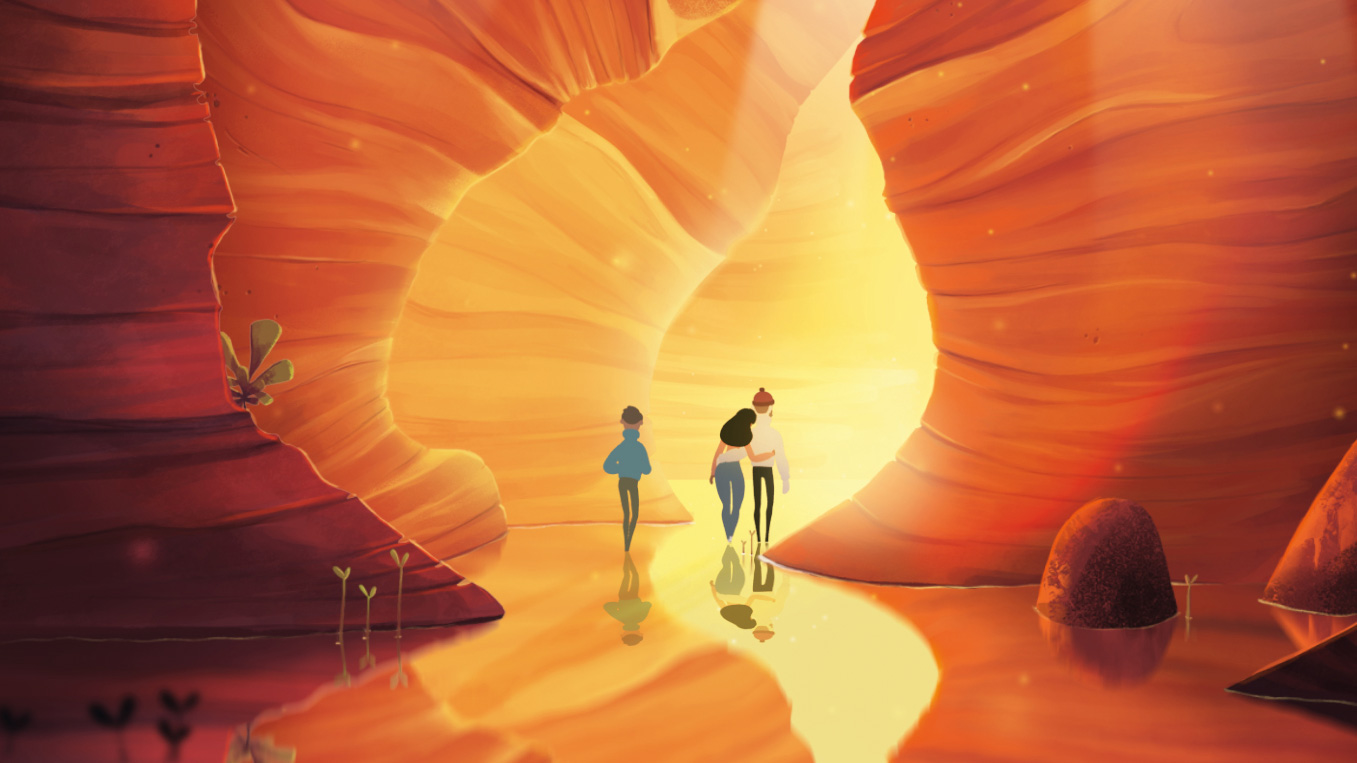How to make an animated video: Expert advice
Leading artists share their tips for stellar animated short videos.

Want to learn how to make an animated video? We've gathered industry-leading artists and storytellers for a masterclass in making engaging animated shorts. The world of short animated films is a rich corner of the 3D community, presenting viewers with quick bursts of creativity, while granting the individuals behind them an opportunity to experiment with visual styles and storytelling techniques.
Such is the value of animated shorts as a medium that London-based studio Blue Zoo has a programme that allows its artists to direct their own, and bring it to life with the help of their colleagues. 3D World spoke to three such artists to find out how you can create your own animated short. Elsewhere, 3D generalist Rok won Hwang will share insights from the process of creating Bruised, the short film he worked on with Samantha Tu.
For more inspiration, browse our collection of amazing animated music videos. Or, if you're making your own movies, see our guide to Disney's 12 principles of animation or our pick of the best video editing software.
Find your idea
Before you figure out how to make an animated video, you need to come up with a concept. Every animated short begins with an idea that forms the initial concept, and it’s from this moment of inspiration that the film takes shape. Let's take a look at the inspiration behind some of the most effective ideas.
01. Make it personal
Inspiration can also come from a personal place, as was the case for Izzy Burton, the director and artist behind Blue Zoo Animation’s award-winning short Via (scroll to step #7 to watch it). “The idea for Via formed from a simple wish to make a short film that highlighted my love for environmental art,” says Burton. “Initially it was going to be a personal project so I had limited the animation to one walk cycle of a man traversing different environments.”
As Blue Zoo allowed Burton to utilise more of the team, Via developed into the human story of three characters. The short shares its name with a poem by Rachel Cladingbowl, which narrates the entire film. “A lot of people think via is formed around the poem, but actually the poem came much later,” explains Burton. “About six months in once the story was already developed, it just fit perfectly into what I had created.”
02. Find a cause you're passionate about
For Hwang and his short film Bruised, it began in the winter of 2017, at Ringling College of Art & Design in Florida. “I watched a video on YouTube about domestic violence and child abuse by chance and it really caught my attention,” he tells us. “In the video, it told me that around a quarter of children under 18 in America experience child abuse, whether it’s physical, psychological or verbal.” These shocking statistics inspired Hwang and his thesis partner Samantha Tu to work on a film about child abuse.
03. Find an untold story
For Dane Winn, director of Blue Zoo’s latest short Ada (watch the trailer at step #9), history proved to be the ultimate inspiration. “The film was based on the true story of an Alaskan woman named Ada Blackjack,” Winn explains. “In 1921, her son had become ill, so she joined a daring expedition to the arctic to earn the money for his treatment. With no wilderness experience, she had to teach herself to survive.”
Even the short’s hand-drawn style was inspired by Ada’s incredible story and the idea that she, along with her companions, had kept a diary of her time on the island.
“We tried to make something that felt sketched, with minimal environment detail,” says Winn. “Other inspiration came from the designer, Sukanto Debnath, who provided us with some fantastic initial sketches that felt mature and suited this idea well, giving us something to aim for.”
04. Mix up the genre
Will Cook created Blue Zoo’s darkly comic short, Christmas With The Moonies, and was inspired by a rebellious desire to break away from the child-friendly nature of his usual output.
“I knew I wanted to do something dark and gross because I needed to do something different,” he explains. “After a big day of directing Numberblocks jumping around Numberland happily, I sat down to write about eating dead reindeer, manslaughter and festive cheer.”
Further inspiration came from the likes of Killing Eve and Inside No. 9, two series that balance comedy and drama. “It was the soundtrack to Killing Eve that really caught my attention,” Cook continues. “The soundtrack often juxtaposed the visuals, which supplemented the storytelling.” This influenced the decision to have Christmas music soundtrack the Moonies’ misadventures.
Develop your concept
Once the initial concept is established the real fun of creating your animated short can begin. Here are some tips for developing your story.
06. Organise your split sheet
While working on Bruised, Ringling's course requirements meant Hwang and Tu split the workflow evenly between them. The pair began by making a split sheet using Google Sheets for props, character modelling, texturing, animation, and lighting.
“Having a clean and organised split sheet is very important, even if you’re not working in a team,” Hwang adds. “We marked our progress on the sheet so that we could share the status of each shot. We worked in the same lab most of the time, so we could closely communicate and even flexibly help each other if needed.”
07. Try a different dimension
For VIA, Burton was able to apply her passion for environmental art to creating layered environments that were painted in Photoshop, before being spaced apart in Z space using After Effects. The team at Blue Zoo helped to make and animate the characters in Maya before they were brought into the After Effects compositions. This process lends the film its distinctive 2.5D aesthetic.
“Ultimately I wanted the film to feel like an illustration or piece of concept art if you paused it on a single frame,” explains Burton.
“Before painting each environment, I made groups in Photoshop with the layer names so that I could remember to paint things only in the layer in which they would exist in the final thing,” explains Burton. This also ensured the parallax effect would work correctly in After Effects, which is where all the compositing happened.
08. Have faith in your concept
Despite the inevitable technical challenges of creating an animated short, Burton maintains that the biggest challenge was keeping belief in her idea. “It’s so easy for artists to doubt themselves and I had many a moment where I questioned what the hell I was doing,” she admits. “About midway through working on it I had this secret breakdown moment where I thought it wasn’t worth making."
Burton powered through because of Blue Zoo's involvement in the project. "I think if I had been working alone I may have given up on the idea at that point. I’m so glad I didn’t, it taught me a lot of lessons of resilience. I think it’s best to remember that you truly believed the idea was good enough when you started it, so don’t let midway doubts make you forget that.”
09. Strip out everything but the essentials
The logistics of telling your story over the canvas of a short film can also come with its fair share of challenges. “For Ada there was a very long story that could be told,” says Winn, who had to devise a way of presenting Ada Blackjack’s incredible story in the short form.
“It was important for me to narrow down on what I found most compelling about it,” he continues. “I would suggest figuring out your ending; finding the moment you want to leave the audience with will help strip away parts of the story that don’t help get there.”
Secrets of success
As with any creative endeavour, there is no right or wrong way to direct your short. There are, however, some ingredients that 3D World’s experts consider important to the success of any project. Here's how to make an animated video that stands out from the crowd.
10. Don't forget to communicate
For Hwang, communication proved vital. “It doesn’t matter how big or small the team is,” he asserts. “My team was only a team of two, yet communication was a key in creating a film.” He adds that the process would have become needlessly painful without good working relationships.
11. Get familiar with the whole pipeline
When making a 3D short, a good knowledge of the entire pipeline can also prove beneficial. Hwang adds: “You can hire or team up with other artists, so you don’t have to be super proficient with the whole pipeline, storyboarding, character design, animating, modelling, texturing, lighting, rendering and editing, but it’s helpful if you’re at least familiar with each step.”
12. Don't be put off by an unfamiliar process
Unfamiliarity shouldn’t act as a barrier though – there are numerous opportunities to learn as you create your short. According to Burton, all you need to make an animated short is a story and the ability to tell it. “I know so many people who are waiting until they can do certain things before they make anything,” says Burton. “Don’t do that.”
Her advice? Use what you do know and build on that. "I didn’t have all the skills to make VIA when I started, but I didn’t let that stop me," she continues. She resolved to teach herself the skills she didn't know, and ask for help on anything she couldn't figure out. "I treated the whole process as an opportunity to learn and wasn’t going to let anything scare me away from the opportunity to tell a story I wanted to tell.”
13. Stick to your guns
Burton also stresses the importance of integrity and authenticity in your storytelling. “Everyone will have an opinion and a critique for you on your idea or film,” she explains. It’s important to respect the opinions of those you ask for advice, but equally important to stick to your guns when you feel strongly about something.
“There was a time in VIA where I was given advice to keep the wife alive at the end by people whose opinions I greatly respect,” she continues. “I took the advice and drew it up into storyboards, but I found that my idea was a lot about finding strength on your own and being happy with the life you had, it wasn’t about a cutesy, heartwarming moment of a couple together. In the end I didn’t take their advice because it took away from what my film was meant to be, but I did consider it.”
14. Let your story guide your style
Animated shorts are also an opportunity to experiment with visual styles, and with Ada’s hand-drawn aesthetic, Winn has some experience in this area. “I read a quote once that said something like, ‘you don’t figure out what style you want to do, you figure out how you want to communicate an idea’,” he says.
“I think that is very true of animation. A lot of stories can work in a variety of styles and mediums, so I would say decide what you want to say with the story and start experimenting.” Winn and the team at Blue Zoo looked at a host of designs and concept art for Ada, knowing that they wanted to convey something raw, organic and mature.
This article was originally published in 3D World, the world's best-selling magazine for CG artists. Buy issue 241 or subscribe.
Read more:

Thank you for reading 5 articles this month* Join now for unlimited access
Enjoy your first month for just £1 / $1 / €1
*Read 5 free articles per month without a subscription

Join now for unlimited access
Try first month for just £1 / $1 / €1
Get the Creative Bloq Newsletter
Daily design news, reviews, how-tos and more, as picked by the editors.

Brad Thorne was Creative Bloq's Ecommerce Writer, and now works for a PR company specialising in 3D and VFX, Liaison. He previously worked as Features Writer for 3D World and 3D Artist magazines, and has written about everything from 3D modelling to concept art, archviz to engineering, and VR to VFX. For Creative Bloq, his role involved being responsible for creating content around the most cutting-edge technology (think the metaverse and the world of VR) and keeping a keen eye on prices and stock of all the best creative kit.
